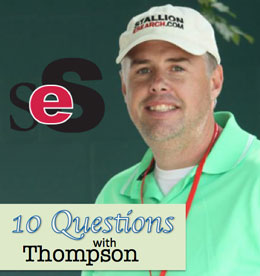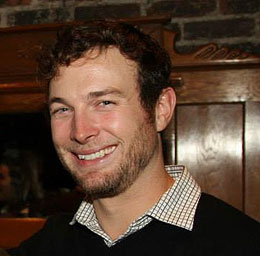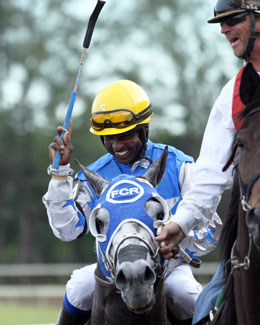- News
- Horse Racing
- Racing Preview
- AQHA Racing Challenge
- Breeding
- Sales
- Quick Stakes Results
- Detail Race Results
- Qualifiers
- Leader Board
- Leading Sires
- Videos
- Auction Leaders
- Q-Racing
Streaming Video

by Greg Thompson, Stallionesearch.com
DALLAS, TX—FEBRUARY 18, 2015—Once in awhile, I come across one of the out-the-ordinary stories in Quarter Horse racing that makes me double take. The story I ran across in Florida at Hialeah was fascinating due to its uniqueness. Imagine a Quarter Horse trainer anchoring his operation smack-dab in the middle of the bluegrass of Lexington, Kentucky. Such a scenario exists.
Trainer Matt Frazier, 33, who has garnered headlines in the past few years with stakes winners like Fredaville, Skyline Lover, Struttin High, and Joltin Jess, is just such a trainer. A trainer born and raised in Kentucky, and still calling it his home to this day, Frazier began his racing career in the thoroughbred-racing world. After time, his operation went from a thoroughbred operation with a few Quarter Horses, to his current predominantly Quarter Horse-based status.
 Trainer Matt Frazier.
© Facebook Photo
Trainer Matt Frazier.
© Facebook Photo
On March 1, 2015 at Hialeah Park, Frazier will send out the 2015 Hialeah Derby winner Seize The Win in the $201,000 South Florida Quarter Horse Derby. I was able to talk with Frazier in the first installment of Ten Questions With Thompson.
1) Stallionesearch: You must get some funny looks from the clockers assistant at the Thoroughbred Training Center when your rider tells him that you are working 330yds.?
Frazier: Needless to say, we are without a doubt ‘the only game in town’ at the ‘Training Center when it comes to Quarter Horses. There are some people there that have worked for 30 to 40 years in Lexington at the facility that have never seen a Quarter Horse break from the gates. When we lead a pair over the gates, we always attract attention. They come looking out of their barns to watch the Quarter Horses work. We are quite the oddity of the training facility there in Lexington.
2) Stallionesearch: With you being born and raised in Kentucky, and with the state being the hub of the thoroughbred breeding universe, I find it interesting that you are so steeped in Quarter Horse racing. What has lead you to this point in your career as Quarter Horse trainer?
Frazier: I started riding when I was 8-year-old. I started competing in team penning before moving onto 10 years worth of running barrels, poles, and flags. We had a friend of the family try to convince my father and I to invest into racing. Eventually my father and I partnered up on 6 thoroughbred yearlings to break and get race ready. I wanted to get into the training as an occupation, so I began the breaking and training of those yearlings with very limited seat time, if any, in a flat saddle. It was a definite “baptism by fire” into the training game. I had thoroughbreds in training for the majority of the first part of my training career. I did some freelance galloping at prestigious thoroughbred places like Walmac International in Lexington, Kentucky in order to make ends meet in the beginning.
 Jockey Shanley Jackson, aboard The Ocean King at Hialeah Park, rides first call for Matt Frazier.
© Coady Photography
Jockey Shanley Jackson, aboard The Ocean King at Hialeah Park, rides first call for Matt Frazier.
© Coady Photography
3) Stallionesearch: What is the key to your success thus far in the short career that you have accumulated in Quarter Horse racing?
Frazier: This operation of mine is a far, far way from being a one man show. It takes a ‘village’, as they say, to keep everything running smoothly as possible. I have the privilege of having some tremendous grooms work for me. My blacksmith, Jerry Meling, is in my opinion is the best in the nation. He has done some great things for us, and made changes that have improved horses drastically over the years. He’s just made a huge difference for us. So the team effort is what I feel has led to our success.
4) Stallionesearch: What is the comparison of training a thoroughbred versus your training method with your Quarter Horses? Where are the similarities?
Frazier: In my opinion the one similarity is the fact that both types of racehorses travel across the same surface, and that is about where the similarity ends. It is a night and day difference between training the two breeds. In training the Quarter Horse, you are utilizing fast twitch muscles. The nutrition is different, but not radically different than feeding a thoroughbred. The training methodology is significantly different. We are not galloping them six days a week, and breezing them every 7 to 10 days like you would a thoroughbred.
With my background in thoroughbreds, I had to really work at learning to properly train a Quarter Horse. It took me about 2.5 years to learn how to not keep them so darn fit. It was my biggest problem starting out. The want and the desire to train on them harder than I needed too, and by doing so I was compromising some of your fast-twitch muscles, was something that took a while for me to get my head around. Going from galloping six days a week to only training 3 or 4 days a week, and at a shorter distance, took some adjustment.
5) Stallionesearch: What are some of the characteristics of your barn that you feel differentiates you from some of the other outfits in Quarter Horse racing?
Frazier: One of the things that differentiates my stable over some of the others is the fact that we do the leg work ‘as if’ they are thoroughbreds. I have some great grooms that stay under horses, and they do some phenomenal leg work for our horses. I make my own poultices, and my own sweats for leg work. I have learned some of the tricks-of-the-trade from some of the older grooms, and kind of tweaked them with some of the more modern liniments to be more effective. This part of our operations was certainly derived from my time with the thoroughbreds. I also gallop my own horses for the most part.
6) Stallionesearch: Your trainee, Seize The Win, won the Hialeah Derby in January, and now is the second-fastest qualifier going into the South Florida Derby. Talk about the horse that is making for a fruitful winter for you this meet at Hialeah.
Frazier: Seize The Win has been really stellar for us thus far this meet. It was a horse that my clients, Glenn and Kelly Graff, had purchased at the Heritage Place Yearling Sale in 2013. When he got to my barn, he quickly earned the nicknames “The Golden Boy” or “The Golden Child”. Some of the grooms refer to him as “El Nino de Oro”(Spanish for The Golden Boy). He is certainly one of those unique horses that you can feel the ‘class’ oozing out of every pore. He has being doing everything right for quite sometime in our barn. The Graff’s gave me all the time I needed to get this horse ready, and he is proof positive that if you give these horse the time they need to develop you will have something really nice. I’ve never had a horse that leaves away from the gate that consistently, and efficiently. In his first three strides, he is able to put down a tremendous amount of power.
7) Stallionesearch: If perhaps he runs well in the South Florida Derby, what are the chances we could see him in some of the G1 Derbies in 2015?
Frazier: Depending on how well he runs at Hialeah in the South Florida Derby, and how well he comes out of the race physically, we will most likely make an attempt at the G1 Heritage Place Derby at Remington Park. And depending on if he excels there, and shows us that he is the type of horse to make a run at the big derbies in Ruidoso, then we will seriously consider supplementing him into an attempt to qualify him for the All American Derby. I am a firm believer of allowing the horse dictate where we run them based off of how well they are training, and how they are performing in the races. But if earns his shot to the mountain I have no issues of saying we will take him to Ruidoso.
8) Stallionesearch: You really seem to love being a trainer. What is it about training that interests you so much and gets you up every morning to do so?
Frazier: One of the things that interests me so much about being a trainer is because I love the aspect of being on the back of a horse so much. As mentioned, I gallop most of my own horses and I love to do that. Training racehorses looks like something that I could do for the rest of my life. It’s always throwing something new at you, and giving you problems and puzzles for you to somehow solve. Sometimes it makes you want to beat your head against the wall, but it is really enjoyable for me to try to figure out what makes each horse tick. I am always striving on how to figure how to get the most I can out of every horse. But I would say that the primary reason for my desire to be a trainer was to afford me the opportunity to ride horses everyday.
9) Stallionesearch: After the Hialeah meet, was in on tap for the Frazier Racing Stable outfit?
Frazier: We have a lot of clients that are steeped heavily into the Indiana-Bred Quarter Horse racing program, so we will be making our way to Indiana Downs after Hialeah closes. The Indiana Quarter Racing program is very solid, and improving and getting deeper every year. As mentioned, I base out of Kentucky at the Thoroughbred Training Center in Lexington, and then have part of the stable at Indiana Downs with an assistant trainer. I have usually about 8 horses on the track, and so I am shuffling horses back and forth to Lexington multiple times a week. We will be making a few runs down to Remington Park for stakes races. I also work with a trainer in Canada, Greg Watson, to send a few horses up for the Challenge races. We will also run a few at Prairie Meadows.
10) Stallionesearch:You have made a formidable partnership with jockey Shanley Jackson. Can you tell us the recipe for that success that you share with your first-call rider?
Frazier: For me, no words can quite describe Shanley Jackson. He is one of the classiest people I’ve ever have had the pleasure to know in my life. He is an excellent race rider, but he is a better human being. Shanley has a tremendous work ethic, and is in the barn 20 minutes before the track opens every morning. I have to sometimes fight with him to let me get on horses, because he wants to ride all of them. You never have to worry about his worth ethic or his attitude. He had a rough spill about a year ago at Indiana Downs, and Shanley ended up with lots of screws and plates from the accident. Lot of riders could not come back from that, and Shanley came back to work when healed saying “lets get to work”. He is just that type of individual. I feel very blessed to have met someone like him in my lifetime, let alone have him be a part of our racing team for almost three years now.

 Newsletters
Newsletters Facebook
Facebook